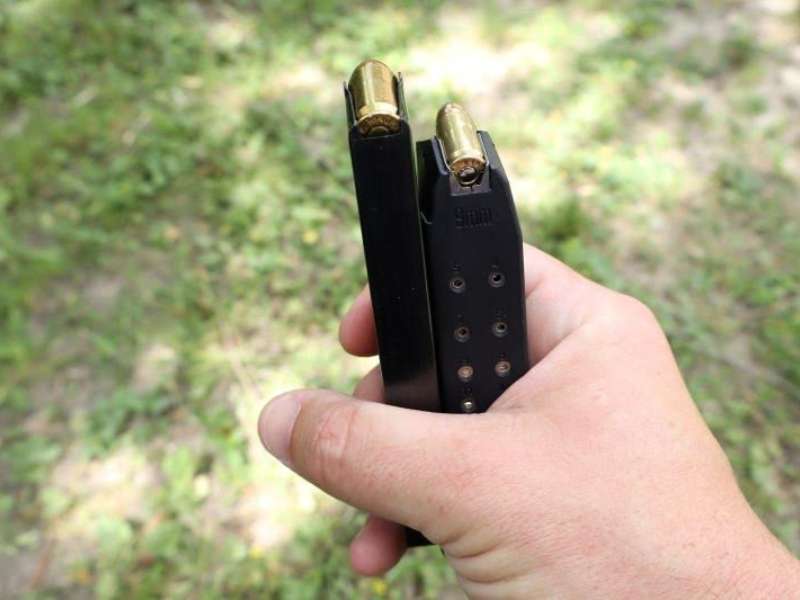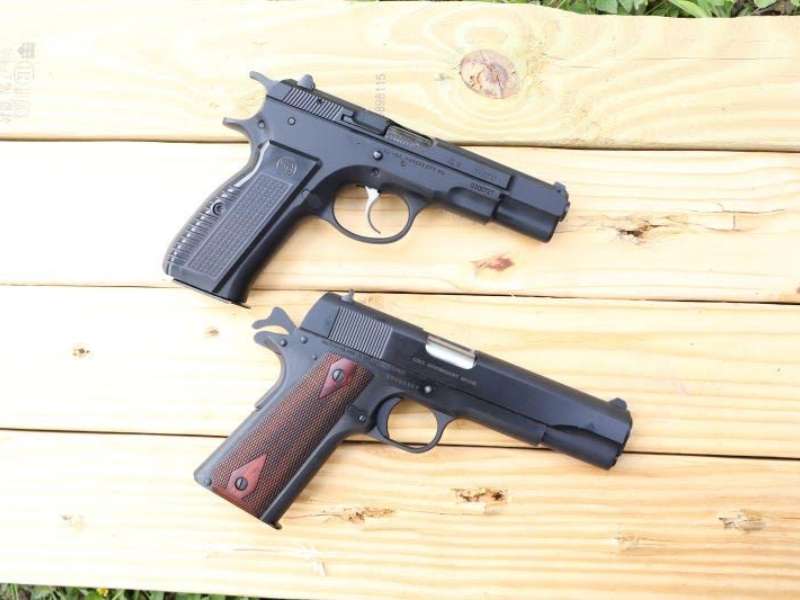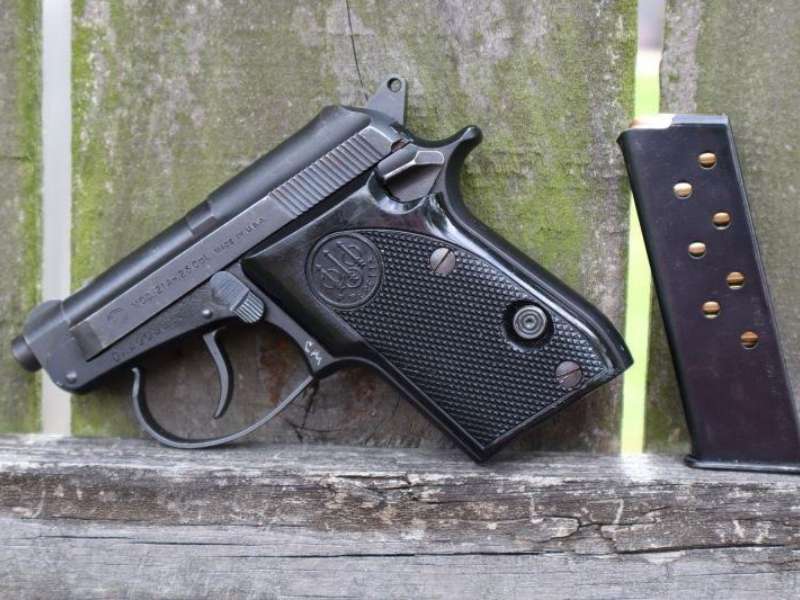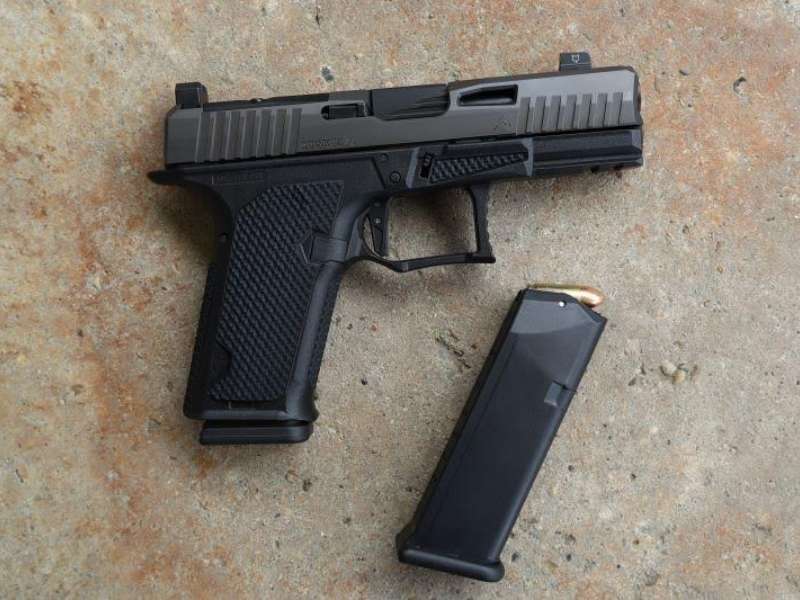Magazine-fed firearms usually fall into two categories of magazine systems: double stack and single stack. Both systems emerged around the same time, and you are liable to run into both when considering your next firearms purchase. Although rifles and some shotguns operate with either system, double stack and single stack guns are generally shorthand for a choice of handgun. Each system has its strengths and weaknesses, and both are worth considering. Let’s discuss.
Double Stacks vs. Single Stacks: What’s the Difference?
The difference between double-stack and single stack magazines starts with how wide each magazine is and how they feed. Single stack magazine feeds one round directly on top of the next to form a single stack.

Double stack magazines have a body that holds two columns or two stacks of ammunition staggered in the magazine instead of one. These magazines usually taper at the top toward the feed lips so that the magazine spring feeds one round at a time, whichever is highest in the staggered formation. This is called a single-feed magazine. Some magazines have wider feed lips and are classed as double-feed.
The Development of Single Stack and Double Stack Magazines
Although double stack magazines are more popular now and are considered more modern, magazines like them have been around for about as long as single stack magazines. The Lee Metford rifle adopted by the British Army in 1888 featured a twelve-shot detachable double stack magazine. The later Lee Enfield carried over that feature. Other military rifles like the Mauser 98 and civilian rifles like the lever-action Savage Model 99 also featured flush-fit, albeit fixed, double stack magazines.
In handguns, the course to get a detachable magazine was more rocky. Many early pistols had fixed magazines until Browning and Luger popularized the detachable single stack magazine in their Model 1900 pistols. The first recognizable double stack magazine pistol was the Savage Model 1907. It held ten rounds of .32 ACP, compared to the seven in the Browning 1900.
This added capacity became the goal gun makers aimed for when turning to double stack magazines, while single stack magazines equated to a thinner and more concealable handgun. Only a few years after developing the single stack Colt 1911, Browning was toying with improving it by employing a double stack magazine. This became the Browning Hi Power, which held thirteen rounds of 9mm, several more than its nearest competitor. In most modern handguns, you are apt to find feature magazines based on the double stack, single feed Browning design.

Full Size, Compacts, Micro Compacts, Oh My!
In the last few years, manufacturers like Sig and Springfield began to build micro compact 9mm handguns based around a scaled-down double stack design that still afforded more rounds over competing single stack guns with pistols only marginally larger. The Sig P365 was the first such pistol. It holds ten rounds in a flush-fitting magazine while competing single stacks in the same size and weight class hold seven or eight. This recent tweak to magazine development blurs some of the hard and fast facts about single stack and double stack magazines.
Double Stacks Still Rule the Day
When capacity is the name of the game, the double stack magazine is the way to go. For every inch of grip, your pistol will hold more ammo than a single stack. This is paramount for law enforcement, military, and competition applications.
But there is no free lunch. To stagger those rounds and get more capacity, the magazine body itself has to be wider to accommodate. This means the pistol’s grip has to be wider for the magazine. This creates a boxy handgun that is uncomfortable to carry and trickier to conceal. For shooters with smaller hands, the wider grip makes trigger reach and proper control a challenge. Although gun makers have attempted creative grip whittling and micro compact magazine designs, single stack magazines still make for a slimmer handgun.
Single Stacks: Still Hanging On
Single stack magazines would have to be hilariously long to compete with double stack magazines to reach an equal capacity. With single stack magazines, you are giving up capacity. In addition, slimmer handguns can deliver a more pronounced punch to the hand under recoil. But single stack guns have their place.
Although micro compact magazines have come close to the same size as single stack handguns, those guns are still marginally thicker and heavier, thanks to the extra ammo. If you are seeking out a handgun for deep cover, you might stick with a single stack handgun.

Single stack magazines can also be more reliable, depending on the caliber of firearm you pick. For most of us, we use modern rimless ammunition like 9mm, 45 ACP, or 5.56 NATO. But a surprising number of rifles and pistols use rimmed or semi-rimmed ammo. For example, many .22 LR pistols and rifles still use single stack single-feed magazines. That is because the rim of one round has to precede the rim of the next cartridge in the magazine. The same applies to pistols in rounds like .25 ACP and .32 ACP. The old Lee Metford and Lee Enfield rifles required careful loading to prevent rims from locking. If a rimlock happens, the magazine is toast. The single-stack option is often best because there are fewer rounds and less movement in the magazine to cause issues.
Double Stacks vs. Single Stacks: The Bottom Line
Double-stack and single-stack magazines have a rich development history, and both are proven and reliable designs, provided that a quality firearm is at play. However, deciding between single-stack and double-stack magazines when selecting a rifle is usually determined by the rifle you select. Rifles in rimfire cartridges or chambering particularly large centerfire cartridges like .400 Legend or .450 Bushmaster are often found with single-stack magazines, while AR, AK, and traditional semi-auto and bolt-action rifles are almost always double-stack.
With handguns, the debate is more nuanced. You might decide on a single-stack 1911 or a double-stack 2011, with similar features and operation but different magazine systems. In the realm of duty and concealed carry handguns, single-stack and double-stack guns in the same class compete against one another.
These options come down to what you expect a handgun to do and what you are comfortable with. A single-stack pistol might fit the bill if you are okay with less ammo but prize concealability. If you need capacity, double-stack is the name of the game. The new generation of micro compacts helps split the difference, although it is not as cut and dry as simply looking at a handgun through the display case. Get a grip and find what is best for you.
Additional Reading:
- Double-Stack 1911 Mags: 11 for 2011s
- Just in Case: The Rationale for Spare Gun Magazines on Ammoland
- Clip vs. Magazine: What’s The Difference? by Jim Davis
We work pretty hard on this stuff. Do us a solid if you’re getting anything out of our writing!











0 Comments